Pattern (sewing)
In sewing and fashion design, a pattern is the template from which the parts of a garment are traced onto fabric before being cut out and assembled. Patterns are usually made of paper, and are sometimes made of sturdier materials like paperboard or cardboard if they need to be more robust to withstand repeated use. The process of making or cutting patterns is sometimes condensed to the one-word Patternmaking, but it can also be written pattern(-)making or pattern cutting.
.jpg)
A sloper pattern (home sewing) or block pattern (industrial production) is a custom-fitted, basic pattern from which patterns for many different styles can be developed. The process of changing the size of a finished pattern is called grading.
Several companies, like Butterick and Simplicity, specialize in selling pre-graded patterns directly to consumers who will sew the patterns at home. Commercial clothing manufacturers make their own patterns in-house as part of their design and production process, usually employing at least one specialized patternmaker. In bespoke clothing, slopers and patterns must be developed for each client, while for commercial production, patterns will be made to fit several standard body sizes.
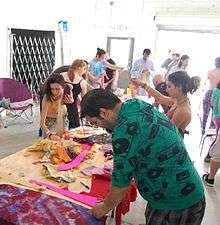
Pattern making
A patternmaker typically employs one of two methods to create a pattern.
The flat-pattern method is where the entire pattern is drafted on a flat surface from measurements, using rulers, curves and straight-edges. A pattern maker would also use various tools such as a notcher, drill and awl to mark the pattern. Usually, flat patterning begins with the creation of a sloper or block pattern, a simple, fitted garment made to the wearer's measurements. For women, this will usually be a jewel-neck bodice and narrow skirt, and for men an upper sloper and a pants sloper. The final sloper pattern is usually made of cardboard or paperboard, without seam allowances or style details (thicker paper or cardboard allows repeated tracing and pattern development from the original sloper). Once the shape of the sloper has been refined by making a series of mock-up garments called toiles (UK) or muslins (US), the final sloper can be used in turn to create patterns for many styles of garments with varying necklines, sleeves, dart placements, and so on. The flat pattern drafting method is the most commonly used method in menswear; menswear rarely involves draping. You can learn pattern drafting on many fashion design courses either on a short further education course or as part of a Fashion degree at a university.
The draping method involves creating a muslin mock-up pattern by pinning fabric directly on a form, then transferring the muslin outline and markings onto a paper pattern or using the muslin as the pattern itself.[1]. Designers drafting an evening gown or a sculpted dress which uses a lot of fabric, typically cut on the bias, will use the draping technique, as it is very difficult to produce with a flat pattern.
Pattern digitizing
After a paper/fabric pattern is completed, very often pattern-makers digitize their patterns for archiving and vendor communication purposes. The previous standard for digitizing was the digitizing tablet. Nowadays, automatic option such as scanner and cameras systems are available.
Fitting patterns
Mass market patterns are made standardized, while human bodies vary, so store-bought patterns only fit a small proportion of people well, and an experienced sewist can adjust standard patterns to better fit any body shape.
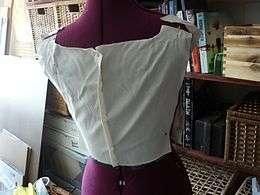
So, a sewist may choose a standard size (usually from the wearer's bust measurement) that has been pre-graded on a purchased pattern. They may decide to tailor or adjust a pattern to improve the fit or style for the garment wearer, using french curves, hip curves, and cutting or folding on straight edges. There are alternate methods, either directly on flat pattern pieces from measurements, using a pre-draped personalized sloper or using draping methods on a dress form with inexpensive fabrics like muslin.
Creating a muslin (also called toile using calico), similar to a garment template, is one method of fitting. Muslin material is inexpensive and is easy to work with when making quick adjustments by pinning the fabric around the wearer or a dress form. The sewist cuts muslin pieces using the same method that they will use for the actual garment, according to a pattern. The muslin pieces are then fit together and darts and other adjustments are made. This provides the sewer with measurements to use as a guideline for marking the pattern pieces and cutting the fabric for the finished garment.[2]
Pattern grading
Pattern grading is the process of shrinking or enlarging a finished pattern to accommodate it to people of different sizes. Grading rules determine how patterns increase or decrease to create different sizes. Fabric type also influences pattern grading standards. The cost of pattern grading is incomplete without considering marker making.
Standard pattern symbols
Sewing patterns typically include standard symbols and marks that guide the cutter and/or sewer in cutting and assembling the pieces of the pattern. Patterns may use:[3][4]
- Notches, to indicate:
- Seam allowances. (not all patterns include allowances)
- Centerlines and other lines important to the fit like the waistline, hip, breast, shoulder tip, etc.
- Zipper placement
- Fold point for folded hems and facings
- Matched points, especially for long or curving seams or seams with ease. For example, the Armscye will usually be notched at the point where ease should begin to be added to the sleeve cap. There is usually no ease through the underarm.
- Circular holes, perhaps made by an awl or circular punch, to indicate:
- A dart apex
- Corners, as they are stitched, i.e. without seam allowances
- Pocket placement, or the placement of other details like trimming
- Buttonholes and buttons
- A long arrow, drawn on top of the pattern, to indicate:
- Grainline, or how the pattern should be aligned with the fabric. The arrow is meant to be aligned parallel to the straight grain of the fabric. A long arrow with arrowheads at both ends indicates that either of two orientations is possible. An arrow with one head probably indicates that the fabric has a direction to it which needs to be considered, such as a pattern which should face up when the wearer is standing.
- Double lines indicating where the pattern may be lengthened or shortened for a different fit
- Dot, triangle, or square symbols, to provide "match points" for adjoining pattern pieces, similar to putting puzzle pieces together
Many patterns will also have full outlines for some features, like for a patch pocket, making it easier to visualize how things go together.
Patterns for commercial clothing manufacture
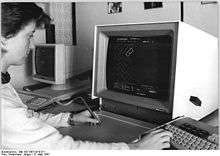
The making of industrial patterns begins with an existing block pattern that most closely resembles the designer's vision.[5] Patterns are cut of oak tag (manila folder) paper, punched with a hole and stored by hanging with a special hook. The pattern is first checked for accuracy, then it is cut out of sample fabrics and the resulting garment is fit-tested. Once the pattern meets the designer's approval, a small production run of selling samples is made and the style is presented to buyers in wholesale markets. If the style has demonstrated sales potential, the pattern is graded for sizes, usually by computer with an apparel industry specific CAD program. Following grading, the pattern must be vetted; the accuracy of each size and the direct comparison in laying seam lines is done. After these steps have been followed and any errors corrected, the pattern is approved for production. When the manufacturing company is ready to manufacture the style, all of the sizes of each given pattern piece are arranged into a marker, usually by computer. A marker is an arrangement of all of the pattern pieces over the area of the fabric to be cut that minimizes fabric waste while maintaining the desired grainlines. It's sort of like a pattern of patterns from which all pieces will be cut. The marker is then laid on top of the layers of fabric and cut. Commercial markers often include multiple sets of patterns for popular sizes. For example: one set of size Small, two sets of size Medium and one set of size Large. Once the style has been sold and delivered to stores – and if it proves to be quite popular – the pattern of this style will itself become a block, with subsequent generations of patterns developed from it.[5]
Standard designing and adjusting tools
- Hip curve
- L-Square
- French curves
- Pattern notcher
- Dress forms
- Slopers - Bodice, skirt, trousers, etc.
Retail patterns
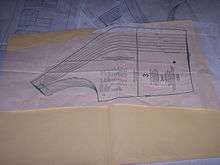

Home sewing patterns are generally printed on tissue paper and sold in packets containing sewing instructions and suggestions for fabric and trim. They are also available over the Internet as downloadable files.[6] Home sewers can print the patterns at home or take the electronic file to a business that does copying and printing. Many pattern companies distribute sewing patterns as electronic files as an alternative to, or in place of, pre-printed packets, which the home sewist can print at home or take to a local copyshop, as they include large format printing versions. Modern patterns are available in a wide range of prices, sizes, styles, and sewing skill levels, to meet the needs of consumers.
The majority of modern-day home sewing patterns contain multiple sizes in one pattern. Once a pattern is removed from a package, you can either cut the pattern based on the size you will be making or you can preserve the pattern by tracing it. The pattern is traced onto fabric using one of several methods. In one method, tracing paper with transferable ink on one side is placed between the pattern and the fabric. A tracing wheel is moved over the pattern outlines, transferring the markings onto the fabric with ink that is removable by erasing or washing.[7] In another method, tracing paper is laid directly over a purchased pattern, and the pieces are traced. The pieces are cut, then the tracing paper is pinned and/or basted to the fabric. The fabric can then be cut to match the outlines on the tracing paper. Vintage patterns may come with small holes pre-punched into the pattern paper. These are for creating tailor's tacks, a type of basting where thread is sewn into the fabric in short lengths to serve as a guideline for cutting and assembling fabric pieces.
Besides illustrating the finished garment, pattern envelopes typically include charts for sizing, the number of pieces included in a pattern, and suggested fabrics and necessary sewing notions and supplies.
Ebenezer Butterick invented the commercially produced graded home sewing pattern in 1863 (based on grading systems used by Victorian tailors), originally selling hand-drawn patterns for men's and boys' clothing. In 1866, Butterick added patterns for women's clothing, which remains the heart of the home sewing pattern market today.[8]
Pattern companies
Commercial sewing pattern companies
Independent (Indie) sewing pattern companies
- By Hand London
- Cashmerette - plus-size patterns
- Closet Case Patterns
- Colette
- Dress Well Made - curvy, large-bust patterns
- Deer and Doe
- Grainline Studio
- I AM Patterns
- Jennifer Lauren Handmade
- Megan Nielsen
- Named Clothing
- Pauline Alice Patterns
- Tilly and the Buttons - beginner patterns
- SBCC Patterns - petite patterns
- Sew Over It - vintage style
- The Avid Seamstress - modern patterns
- Thread Theory - men's patterns
- Umsiko
- Victory Patterns
- Wearologie
- Wiksten
Making clothes with no patterns
- DIY Couture - Book by Rosie Martin
- Freehand Fashion - Book by Chinelo Bally
Gallery
 Vintage sewing pattern pieces, sold pre-cut
Vintage sewing pattern pieces, sold pre-cut Tracing of a pattern
Tracing of a pattern Sewing a tailor's tack with thread to mark a pattern on fabric before cutting the fabric
Sewing a tailor's tack with thread to mark a pattern on fabric before cutting the fabric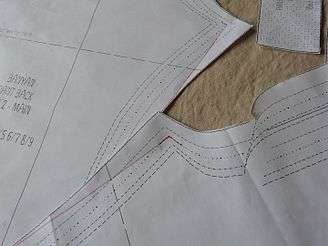 A sewer grades a pattern with red ink, to match measurements tailored to the person who will wear the garment.
A sewer grades a pattern with red ink, to match measurements tailored to the person who will wear the garment.
See also
References
- What is Draping Technique and its Process?. Style2Designer.com. Retrieved on 2016-11-29.
- Whitt, Kay (2010). Sew Serendipity. Krause Publications. pp. 11, 13. ISBN 9781440203572.
- Veblen, Sarah (2012). The Complete Photo Guide to Perfect Fitting. Creative Publishing International. pp. 11–2. ISBN 9781589236080.
- Saunders, Jan (1999). Sewing for Dummies. IDG Books Worldwide. pp. 51–2. ISBN 076455137X.
- Fasanella, Kathleen The Entrepreneur's Guide to Sewn Product Manufacturing, 1998, Apparel Technical Services, ISBN 0966320840
- Camp, Carole Ann (2011). "3: Sewing from a pattern". Teach Yourself VISUALLY Fashion Sewing. John Wiley & Sons. pp. n.p. ISBN 9781118167120.
- Veblen, Sarah (2012). The Complete Photo Guide to Perfect Fitting. Creative Publishing International. p. 19. ISBN 9781589236080.
- "Butterick History". Butterick. Retrieved 26 March 2019.
External links